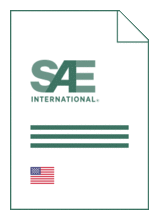
Standard [CURRENT]
SAE J 448:2023-02-06
Surface Texture
- Publication date
- 2023-02-06
- Original language
- English
- Pages
- 9
- Publication date
- 2023-02-06
- Original language
- English
- Pages
- 9
Product information on this site:
Quick delivery via download or delivery service
Buy securely with a credit card or pay upon receipt of invoice
All transactions are encrypted
Short description
This SAE Standard is concerned with the geometrical irregularities of surfaces of solid materials. It established definite classifications for various degrees of roughness and waviness and for several varieties of lay. It also provides a set of symbols for use on drawings and in specifications, reports, and the like. The ranges for roughness and waviness are divided into a number of steps, and the general types of lay are established by type characteristics. This standard does not define what degrees of surface roughness and waviness or what type of lay are suitable for any specific purpose. It does not specify the means by which any degree of such irregularities may be obtained or produced. Neither is it concerned with the other surface qualities such as luster, appearance, color, corrosion resistance, wear resistance, hardness, microstructure, and absorption characteristics, any of which may be governing considerations in specific applications. Sufaces, in general, are very complex in character. Although the height, width, length, shape, and direction of surface irregularities may all be of practical importance in specific applications, this standard deals only with their height, width, and direction.
Loading recommended items...
Loading recommended items...
Loading recommended items...

